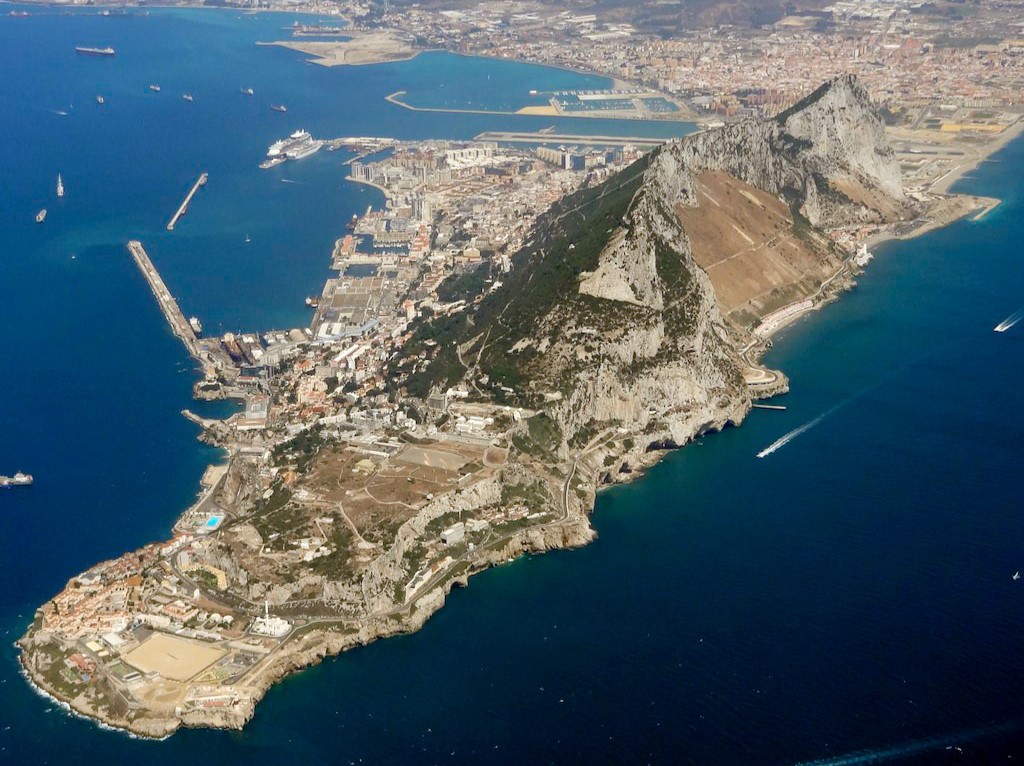Gibraltar from the air, looking north-west. Photo: Steve – Flickr: Gibraltar / CC BY-SA 2.0 DEED.
Operation Goldeneye was an Allied stay-behind plan during World War II, conceptualized to monitor Spain in the event of an alliance between Francisco Franco and the Axis powers. The operation was developed by Commander Ian Fleming of the Naval Intelligence Division (NID) to maintain British communication with Gibraltar and perform sabotage if necessary.
The significance of the operation stemmed from its strategic location: the Strait of Gibraltar. Controlling this passage was crucial for the Allied forces to maintain their naval presence in the Mediterranean and safeguard shipping routes in the Atlantic.
Development of the Plan
In August 1940, Lieutenant Commander Ian Fleming was tasked with drafting Operation Goldeneye. The plan was geared toward countering the potential installation of Axis radar equipment and infrared cameras in the Strait of Gibraltar, which could pose a threat to Allied naval operations.
Under the cover of a courier, Fleming traveled to Gibraltar on February 16, 1941. He coordinated closely with Alan Hillgarth, the British naval attaché in Madrid, who provided vital information for the plan’s guerrilla and sabotage components. Fleming’s mission included establishing a secure communication link between London and the Goldeneye liaison office, controlled by H.L. Greensleeves, an NID agent. Additionally, Fleming set up an office in Tangier to continue operations should Gibraltar fall to the Germans. During his visit, Fleming met with William J. Donovan from the American Office of Strategic Services (OSS) to discuss intelligence coordination.

Operation Phases
In 1942, as the Allies geared up for Operation Torch, the invasion of North Africa, Operation Goldeneye was thrust into a heightened state of alert. This heightened vigilance was primarily driven by the need to counteract the increasing surveillance and sabotage activities of the Axis powers, who were keenly aware of the impending military actions in the Mediterranean. Operation Goldeneye’s mission was to stay one step ahead of the enemy, thwarting their attempts to gather intelligence and execute sabotage operations. The operation’s success was crucial for maintaining the secrecy and integrity of Allied plans and movements, ensuring that the Mediterranean remained a strategic stronghold.
One of the most formidable threats Operation Goldeneye faced was the elite Italian navy frogmen unit known as the Decima Flottiglia MAS (Decima Flottiglia Motoscafi Armati Siluranti, also known as La Decima or Xª MAS, Italian for “10th Torpedo-Armed Motorboat Flotilla”). These highly skilled combat divers took advantage of the wrecked ships in Gibraltar’s waters to launch covert attacks on Allied shipping. The frogmen’s daring and unconventional tactics posed a significant risk to the Allied naval presence in the region. Operation Goldeneye was tasked with monitoring the activities of the 10th Flotilla, gathering intelligence on their operations, and devising countermeasures to disrupt their sabotage efforts. This involved meticulous planning, surveillance, and coordination with other intelligence and military units to neutralize the threat posed by these underwater saboteurs.

Through its efforts to monitor and disrupt Axis activities, Operation Goldeneye played a vital role in safeguarding Allied interests in the Mediterranean. The operation’s success not only protected vital shipping routes but also contributed to the overall strategic objectives of the Allies in the region. By maintaining a constant state of alert and proactively countering enemy actions, Operation Goldeneye ensured that the Allies could carry out their military plans with a greater degree of security and effectiveness.
Legacy
The reduced risk of Nazi occupation of Spain led to the shutdown of Operation Goldeneye in August 1943, along with its asssiciated plan Operation Tracer. Despite its eventual cessation, the operation’s legacy continued to influence post-war espionage and intelligence strategies. Ian Fleming later named his post-war Jamaican estate “Goldeneye,” where he wrote his famous James Bond novels.

Operation Goldeneye’s legacy extended beyond its wartime mission, leaving a lasting impact on popular culture through Ian Fleming’s works. The name “Goldeneye” became synonymous with intrigue and espionage, largely due to Fleming’s James Bond novels and the 1995 film GoldenEye starring Pierce Brosnan as James Bond. GoldenEye is not based on any of Ian Fleming;’s original novels but shares its name with Fleming’s real-life military plan.
In the film, Bond’s mission is to prevent a rogue ex-MI6 agent, Alec Trevelyan, from using a satellite weapon called “GoldenEye” to cause a global financial meltdown. The story begins with Bond and Trevelyan infiltrating a Soviet chemical weapons facility in Arkhangelsk. During the mission, Trevelyan is seemingly killed by Colonel Ourumov, but Bond manages to escape. Nine years later, Bond is assigned to investigate the theft of the GoldenEye satellite weapon by the Janus Syndicate, led by Trevelyan, who is revealed to have survived and turned against MI6.
Bond teams up with Natalya Simonova, a Russian computer programmer who survived the attack on the GoldenEye control center. Together, they uncover Trevelyan’s plan to use the satellite to destroy London and cause a global financial crisis. Along the way, Bond faces off against Trevelyan’s henchwoman, Xenia Onatopp, and other adversaries. The film culminates in a dramatic showdown at the Arecibo Observatory in Puerto Rico, where Bond and Trevelyan engage in a final battle. Bond ultimately defeats Trevelyan and prevents the GoldenEye satellite from causing catastrophic damage.
GoldenEye was the first Bond film to feature Pierce Brosnan as James Bond and marked a successful revival of the franchise after a six-year hiatus.
Final Thoughts
Operation Goldeneye remains a fascinating chapter in the history of World War II espionage. It highlights the critical role of intelligence and strategic planning in countering potential threats. Fleming’s work on this operation not only contributed to the Allied war effort but also left a lasting impact on popular culture through the James Bond series.
Resources
The Official Website for Ian Fleming
IanFleming.com
The Official James Bond 007 Website
007.com
Goldeneye
GoldenEye.com
